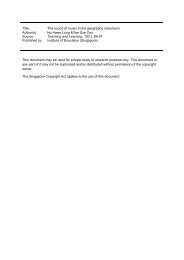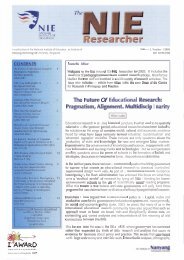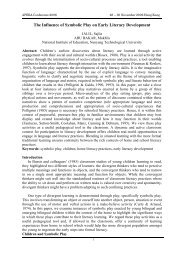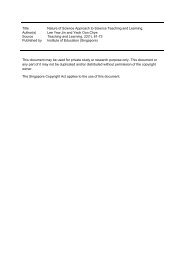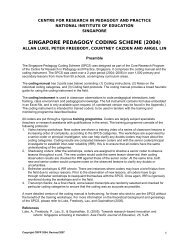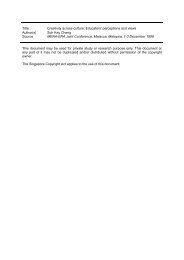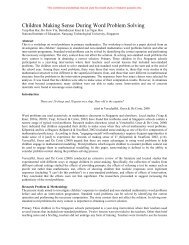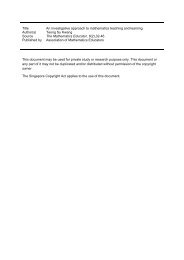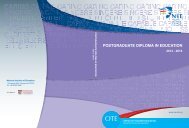Boey Kok Leong an - NIE Digital Repository
Boey Kok Leong an - NIE Digital Repository
Boey Kok Leong an - NIE Digital Repository
Create successful ePaper yourself
Turn your PDF publications into a flip-book with our unique Google optimized e-Paper software.
TitleSingapore students’ trend in the perform<strong>an</strong>ce in mathematics by gender inTIMSS 2003 <strong>an</strong>d 2007Author(s) <strong>Boey</strong> <strong>Kok</strong> <strong>Leong</strong> <strong>an</strong>d Jaguthsing DindyalSource 5th East Asia Regional Conference on Mathematics Education, Tokyo, 18-22 August 2010This document may be used for private study or research purpose only. This document or<strong>an</strong>y part of it may not be duplicated <strong>an</strong>d/or distributed without permission of the copyrightowner.The Singapore Copyright Act applies to the use of this document.
Singapore Students’ Trend in the Perform<strong>an</strong>ce in Mathematics by GenderIn TIMSS 2003 <strong>an</strong>d 2007<strong>Boey</strong> <strong>Kok</strong> <strong>Leong</strong><strong>NIE</strong>, N<strong>an</strong>y<strong>an</strong>g Technological Universitykokleong.boey@nie.edu.sgJaguthsing Dindyal<strong>NIE</strong>, N<strong>an</strong>y<strong>an</strong>g Technological Universityjaguthsing.dindyal@nie.edu.sgAbstractIn this study we report the secondary <strong>an</strong>alysis of the gender-related data from theTrends in International Mathematics <strong>an</strong>d Science Study in 2003 <strong>an</strong>d 2007 (TIMSS2003 & 2007) for Singapore students in Mathematics. It was noted that girls inSingapore performed signific<strong>an</strong>tly better th<strong>an</strong> boys in TIMSS 2007 at both grades 4 <strong>an</strong>d8 in mathematics. Similar results for mathematics were obtained in the TIMSS 2003whereby, in addition, girls from Singapore performed better th<strong>an</strong> boys in all reportedcontent domains at grades 4 <strong>an</strong>d 8.Keywords: TIMSS 2007 Grade 8, TIMSS 2003 Grade 4, Mathematics, GenderIn 2000, gender equality became one of the eight United Nations MillenniumDevelopment Goals. As such, gender has emerged internationally as a social <strong>an</strong>dpolitical issue (Adams, 2002). It is import<strong>an</strong>t to mention that we look at gender not onlyfrom the perspective of females but also as a male issue. We shall take a closer lookat the perform<strong>an</strong>ce of grade 4 students in 2003 <strong>an</strong>d grade 8 students four years later.In this presentation, we report the secondary <strong>an</strong>alysis of the Mathematics data forSingapore from the TIMSS International Data Base <strong>an</strong>d the International TIMSS Report(Mullis, Martin, & Foy, 2008), with a focus on gender. TIMSS 2003 data were used toprovide for comparison of the data from TIMSS 2007 (see Mullis, Martin, & Foy, 2004).Also, for <strong>an</strong> overview of the gender perspective we included the gender related fromthe top-five performing countries in mathematics. In our <strong>an</strong>alysis, we looked into theoverall perform<strong>an</strong>ce in mathematics of the students <strong>an</strong>d their perform<strong>an</strong>ce by genderwithin content domains <strong>an</strong>d cognitive domains at grade 4 in 2003 <strong>an</strong>d grade 8 in 2007.Students’ self-confidence was also examined from a gender perspective. The samplein the <strong>an</strong>alyses presented were responses from the international databases from thesetwo studies. SAS was utilised to compute various statistics <strong>an</strong>d the correspondingst<strong>an</strong>dard errors. The perform<strong>an</strong>ce by gender of the students on the TIMSS 2003 <strong>an</strong>d2007 mathematics items was also examined. In addition, we look at achievementitems from each of the content domains for signific<strong>an</strong>t differences in perform<strong>an</strong>ce bystudent gender, paying particular attention to the trend items.DataTIMSS surveyed students in their fourth <strong>an</strong>d eighth years of school. The datacollected from the students <strong>an</strong>d their teachers provided <strong>an</strong> opportunity to investigateresults by gender for both Mathematics <strong>an</strong>d Science. The TIMSS 2003 (Martin, 2005)<strong>an</strong>d 2007 data (Foy & Olson, 2009) has been used in the <strong>an</strong>alysis of the results of thispaper. A word of caution is appropriate here; since, the sampling of the teachers inTIMSS 2003 <strong>an</strong>d 2007 were based on participating students (i.e. the Mathematics <strong>an</strong>dScience teachers of the sampled students were sampled), teachers’ responses did notnecessarily represent all teachers of each grade. The responses only representedteachers of the representative samples of students assessed.
FindingsTeachers’ genderFor TIMSS 2003 at grade 4, each East Asi<strong>an</strong> country had larger percentages ofstudents taught by female teachers for mathematics th<strong>an</strong> male teachers (see Table 1).In TIMSS 2007 at grade 8, however, only Chinese Taipei, Korea <strong>an</strong>d Singapore hadlarger percentages of students taught by female teachers th<strong>an</strong> male teachers.Table 1: Percentage of Pupils by Teacher Gender in TIMSS 2003 & 2007 from the top5 performing countriesGrade 4 in 2003 Grade 8 in 2007CountryFemale Male Female MaleChinese Taipei 80 (2.9) 20 (2.9) 57 (4.4) 43 (4.4)Hong Kong, SAR 73 (4.3) 27 (4.3) 40 (3.8) 60 (3.8)Jap<strong>an</strong> 63 (3.8) 37 (3.8) 43 (3.7) 57 (3.7)Korea - - - - 64 (3.2) 36 (3.2)Singapore 82 (3.1) 18 (3.1) 64 (2.7) 36 (2.7)International Average 80 (0.6) 20 (0.6) 57 (0.5) 43 (0.5)Source: Exhibits 6.3 in (Mullis, 2004), exhibits 6.1 in (Mullis, 2008)( ) St<strong>an</strong>dard errors appear in parenthesis.International averages were obtained by averaging the me<strong>an</strong> scores for each of the participating countriesWith the exception of Hong Kong <strong>an</strong>d Jap<strong>an</strong> in TIMSS 2003 grade 4, there wasinsufficient evidence to conclude that there was a relationship in each country betweenperform<strong>an</strong>ce by boys or girls <strong>an</strong>d their teachers’ gender for each TIMSS. However, itwas also noted that in each TIMSS, students taught by female teachers eitheroutperformed or performed as well as students taught by male teachers (see Tables2A, 2B, 3A & 3B). It was noted that in Jap<strong>an</strong>, there was no signific<strong>an</strong>t differences inthe perform<strong>an</strong>ce by <strong>an</strong>y of the groups.Table 2A: TIMSS 2003 Grade 4 Me<strong>an</strong> Scores by Teacher/Student GenderCountry F/G F/B M/G M/BChisquarep-valueChineseTaipei567 (1.7) 565 (2.0) 554 (4.4) 557 (6.5) 0.0112 0.9158Hong Kong,SAR577 (3.4) 576 (3.7) 569 (7.8) 570 (7.0) 0.0017 0.9667Jap<strong>an</strong> 562 (2.4) 567 (2.5) 563 (3.4) 566 (3.9) 0.0018 0.9664Singapore 607 (5.3) 599 (6.2) 550 (11.5) 558 (12.2) 0.1108 0.7392( ) St<strong>an</strong>dard errors appear in parenthesisF: Female teacher M: Male teacher B: Boy G: Girl
Table 2B: Comparison of TIMSS 2003 Grade 4 Me<strong>an</strong> Mathematics Scoresby Teacher/Student GenderChineseTaipeiF/G F/B M/G M/BHong Kong,SARF/G F/B M/G M/BF/G ○ ○ ▲ ○ F/G ○ ○ ○ ○F/B ○ ○ ▲ ○ F/B ○ ○ ○ ○M/G ▼ ▼ ○ ○ M/G ○ ○ ○ ○M/B ○ ○ ○ ○ M/B ○ ○ ○ ○Jap<strong>an</strong> F/G F/B M/G M/B Singapore F/G F/B M/G M/BF/G ○ ○ ○ ○ F/G ○ ○ ▲ ▲F/B ○ ○ ○ ○ F/B ○ ○ ▲ ▲M/G ○ ○ ○ ○ M/G ▼ ▼ ○ ○M/B ○ ○ ○ ○ M/B ▼ ▼ ○ ○F: Female teacher M: Male teacher B: Boy G: GirlAn arrow pointing upwards indicates the group in the row has a signific<strong>an</strong>tly higher me<strong>an</strong> score th<strong>an</strong> thecorresponding group in the column. A downward arrow indicates a signific<strong>an</strong>tly lower me<strong>an</strong> score (of therow group relative to the column group).Table 3A: TIMSS 2007 Grade 8 Me<strong>an</strong> Scores by Teacher/Student GenderCountry F/G F/B M/G M/BChisquarevaluep-Chinese Taipei 600 (5.2) 597 (6.2) 597 (8.2) 600 (9.6) 0.013 0.9092Hong Kong,SAR597 (7.4) 565 (16.9) 568 (7.2) 569 (8.9) 0.4453 0.5046Jap<strong>an</strong> 572 (6.8) 578 (5.2) 565 (4.7) 568 (4.3) 0.0048 0.9445Rep of Korea 601 (4.5) 600 (4.6) 581 (4.8) 598 (6.0) 0.1225 0.7264Singapore 604 (5.0) 590 (6.0) 595 (9.1) 577 (8.6) 0.0098 0.9213( ) St<strong>an</strong>dard errors appear in parenthesisF: Female teacher M: Male teacher B: Boy G: GirlTable 3B: Comparison of TIMSS 2007 Grade 8 Me<strong>an</strong> Mathematics Scores byTeacher/Student GenderChinese TaipeiHong Kong,F/G F/B M/G M/B& Jap<strong>an</strong>SARF/G F/B M/G M/BF/G ○ ○ ○ ○ F/G ○ ○ ▲ ▲F/B ○ ○ ○ ○ F/B ○ ○ ○ ○M/G ○ ○ ○ ○ M/G ▼ ○ ○ ○M/B ○ ○ ○ ○ M/B ▼ ○ ○ ○Rep of Korea F/G F/B M/G M/B Singapore F/G F/B M/G M/BF/G ○ ○ ▲ ○ F/G ○ ○ ○ ▲F/B ○ ○ ▲ ○ F/B ○ ○ ○ ○M/G ▼ ▼ ○ ▼ M/G ○ ○ ○ ○M/B ○ ○ ▲ ○ M/B ▼ ○ ○ ○F: Female teacher M: Male teacher B: Boy G: GirlAn arrow pointing upwards indicates the group in the row has a signific<strong>an</strong>tly higher me<strong>an</strong> score th<strong>an</strong> thecorresponding group in the column. A downward arrow indicates a signific<strong>an</strong>tly lower me<strong>an</strong> score (of therow group relative to the column group).
In TIMSS 2003, girls outperformed boys at grade 4 in the knowledge <strong>an</strong>dapplying cognitive domains in Singapore (see Table 4) Internationally as well asChinese Taipei, Hong Kong <strong>an</strong>d Jap<strong>an</strong>, girls performed as well as the boys. 4 yearslater in TIMSS 2007, more differences were noted. In each of the 3 cognitive domains,girls had higher achievement scores in Mathematics th<strong>an</strong> boys at grade 8, both inSingapore <strong>an</strong>d internationally (see Table 5), as well as girls from Hong Kong in theApplying domain.Table 4: Average Achievement in the Mathematics Cognitive Domains by Gender atGrade 4 in TIMSS 2003CountryKnowledge Applying ReasoningGirl Boy Girl Boy Girl BoyChinese Taipei 564 (2.4) 566 (2.6) 561 (2.0) 562 (2.2) 565 (2.6) 562 (2.7)Hong Kong SAR 574 (3.9) 573 (3.6) 576 (3.5) 577 (3.5) 565 (4.0) 563 (3.8)Jap<strong>an</strong> 565 (2.6) 564 (3.0) 563 (2.6) 569 (2.3) 559 (2.1) 564 (2.6)Singapore 632 (6.4) ▲ 620 (7.2) 599 (5.8)▲ 590 (6.6) 578 (6.2) 570 (6.8)International Avg 496 (0.9) 495 (0.9) 494 (0.8) 497 (0.8) 496 (0.9) 495 (0.8)( ) St<strong>an</strong>dard errors appear in parenthesisSource: Exhibits 3.1, 3.2 & 3.3 in (Mullis, 2004)▲Me<strong>an</strong> achievement signific<strong>an</strong>tly higher th<strong>an</strong> the other gender in that domain.Table 5: Average Achievement in the Mathematics Cognitive Domains by Gender atGrade 8 in TIMSS 2007CountryKnowledge Applying ReasoningGirl Boy Girl Boy Girl BoyChinese Taipei 592 (4.3) 593 (4.9) 596 (4.5) 592 (5.6) 591 (4.4) 592 (5.1)Hong Kong SAR 573 (4.9) 564 (8.1) 580 (4.8) ▲ 567 (7.3) 563 (5.0) 551 (7.9)Jap<strong>an</strong> 562 (3.2) 569 (2.9) 560 (2.8) 560 (3.3) 568 (3.4) 567 (3.5)Rep of Korea 592 (3.7) 598 (3.4) 597 (3.7) 596 (2.8) 577 (3.1) 580 (2.7)Singapore 600 (3.9) ▲ 586 (4.4) 590 (3.8) ▲ 573 (4.2) 586 (4.6) ▲ 571 (4.9)International Avg 452 (0.6) ▲ 450 (0.6) 454 (0.6) ▲ 447 (0.6) 471 (0.6) ▲ 465 (0.7)( ) St<strong>an</strong>dard errors appear in parenthesisSource: Exhibit 3.3 in (Mullis, 2008)▲Me<strong>an</strong> achievement signific<strong>an</strong>tly higher th<strong>an</strong> the other gender in that domain.In TIMSS 2003, girls at grade 4 outperformed boys in Geometry <strong>an</strong>d Data inSingapore <strong>an</strong>d internationally (see Table 6). The same cohort of students continued toshow this trend in TIMSS 2007 grade 8 (see Table 7). Girls in Singapore performedbetter th<strong>an</strong> boys grade 4 in Number topics but there was no difference 4 years later.We also noted that the gap between boys <strong>an</strong>d girls in Jap<strong>an</strong> seemed to have widened.It was the reverse for Algebra 1 .1 We compare results between topics in Patterns <strong>an</strong>d relationship at grade 4 with Algebra at grade 8.
Table 6: Average Achievement in Mathematics Content Areas by Gender for TIMSS2003 Grade 4Content Area Number Patterns & Measurement Geometry DataRelationshipCountry Girl Boy Girl Boy Girl Boy Girl Boy Girl BoyChineseTaipei568(2.5)567(2.1)555(2.4)555(2.9)556(2.0)552(2.1)593(4.9)591(5.3)567(4.5)564(4.1)Hong Kong,SAR575(3.5)573(3.6)568(4.4)568(3.6)561(3.0564(2.9)573(4.6)567(7.5)554(4.2)544(6.7)Jap<strong>an</strong> 553(2.5)558(2.3)551(1.9)557(2.0)567(2.0)569(2.0)573(2.9)572(3.2)573(2.5)573(3.1)Singapore 617(5.9)▲InternationalAverage495(0.8)608(6.7)496(0.8)583(5.4)496(0.8)▲575(6.0)495(0.8)569(4.5)493(0.8)564(5.2)498(0.7)586(3.7)▲454(0.6)▲571(4.2)448(0.6)( ) St<strong>an</strong>dard errors appear in parenthesisSource: Exhibit 3.3 in (Mullis, 2004)▲ Me<strong>an</strong> achievement signific<strong>an</strong>tly higher th<strong>an</strong> the opposite gender in that domain.581(4.5)▲453(0.5)▲Table 7: Average Achievement in Mathematics Content Areas by Gender for TIMSS2007 Grade 8568(4.3)449(0.6)Content Area Number Algebra Geometry Data & Ch<strong>an</strong>ceCountry Girl Boy Girl Boy Girl Boy Girl BoyChinese Taipei 574(4.6)579(4.9)622(5.8)613(6.3)593(4.9)591(5.3)567 (4.5) 564(4.1)Hong Kong,SAR570(5.1)564(7.7)573(5.1) ▲558(7.5)573(4.6)567(7.5)554 (4.2) 544(6.7)Jap<strong>an</strong> 545(3.3)558(3.1) ▲560(4.0)559(3.3)573(2.9)572(3.2)573 (2.5) 573(3.1)Rep of Korea 575(3.4)591(2.8) ▲596(4.1)596(3.9)585(2.7)588(3.3)580 (2.5) 579(2.5)Singapore 601(3.9)593(4.3)589(3.9) ▲569(4.5)586(3.7) ▲571(4.2)581 (4.5)▲568(4.3)InternationalAverage448(0.6)453(0.6) ▲457(0.6) ▲444(0.6)454(0.6) ▲448(0.6)453 (0.5)▲449(0.6)( ) St<strong>an</strong>dard errors appear in parenthesisSource: Exhibit 3.3 in (Mullis, 2008)▲ Me<strong>an</strong> achievement signific<strong>an</strong>tly higher th<strong>an</strong> the opposite gender in that domain.Due to limitation of space, the discussion will focus only on results from TIMSS2007 from this point. At Grade 8, the percentage of boys with higher self-confidence inlearning mathematics was signific<strong>an</strong>tly higher th<strong>an</strong> the percentage of girls (Table 8).TIMSS 2007 created <strong>an</strong> Index of Students' Positive Affect Toward Mathematics(PATM) with Trends. This index was based on students’ responses to the following:I enjoy learning Mathematics; Mathematics is boring, <strong>an</strong>d I like Mathematics. Withthe exception of Singapore, the percentage of boys with high PATM wassignific<strong>an</strong>tly higher th<strong>an</strong> the girls from each country (see Table 9).
Table 8: Index of Grade 8 Students' Self-Confidence in Learning Mathematics (SCM)in TIMSS 2007CountryChineseTaipeiHong Kong,SARJap<strong>an</strong>Rep ofKoreaSingaporePercentageAchievementPercentageAchievementPercentageAchievementPercentageAchievementPercentageAchievementHigh SCM Medium SCM Low SCMGirl Boy Girl Boy Girl Boy20 35 25 28 55 37(1.1) (1.4) ▲ (0.9) (1.0) ▲ (1.4) ▲ (1.3)681 671 620 601 560 528(4.6) (4.6) (5.7) ▲ (5.8) (4.8) ▲ (5.4)23 38 39 40 38 23(1.1) (1.5) ▲ (1.2) (1.6) (1.2) ▲ (1.0)627 619 581 542 546 527(5.1) (6.4) (5.8) ▲ (9.3) (6.1) (8.5)11 22 34 36 54 41(0.8) (1.0) ▲ (1.1) (1.2) (1.1) ▲ (1.2)644 634 592 580 537 532(6.0) (4.3) (3.8) ▲ (4.0) (3.6) (3.9)23 33 35 32 41 34(1.0) (1.2) ▲ (1.1) ▲ (0.9) (1.1) ▲ (1.2)670 667 610 602 540 531(3.9) (2.8) (3.9) (3.9) (3.5) (3.8)39 43 33 35 28 22(1.4) (1.3) ▲ (1.1) (1.3) (1.2) ▲ (1.0)645 632 584 562 558 534(4.1) ▲ (4.4) (5.2) ▲ (5.8) (5.5) ▲ (5.9)( ) St<strong>an</strong>dard errors appear in parenthesis▲ Me<strong>an</strong> signific<strong>an</strong>tly higher th<strong>an</strong> the opposite genderTable 9: Index of Grade 8 Students' Positive Affect Toward Mathematics (PATM) inTIMSS 2007CountryChinese TaipeiHong Kong, SARJap<strong>an</strong>Rep of KoreaSingaporePercentageAchievementPercentageAchievementPercentageAchievementPercentageAchievementPercentageAchievementHigh PATM Medium PATM Low PATMGirl Boy Girl Boy Girl Boy30 44 19 18 51 39(1.4) (1.5) ▲ (0.9) (0.9) (1.7) ▲ (1.6)653 660 611 598 562 530(4.7) (4.5) (7.6) (5.7) (4.5) ▲ (6.1)43 50 22 22 35 27(1.5) (1.5) ▲ (1.2) (1.1) (1.4) ▲ (1.7)607 600 579 554 542 519(5.7) (7.4) (5.8) ▲ (8.8) (6.9) (9.9)27 34 29 31 44 36(1.5) (1.2) ▲ (1.3) (1.2) (1.5) ▲ (1.4)612 607 567 567 542 544(5.1) (4.6) (3.7) (4.2) (3.5) (4.2)30 35 22 24 48 41(1.2) (1.2) ▲ (0.8) (0.8) (1.4) ▲ (1.1)648 651 599 600 560 556(3.7) (3.4) (4.8) (4.6) (3.6) (3.8)62 59 20 20 19 21(1.5) (1.2) (1.0) (0.7) (1.1) (1.0)620 609 580 570 557 534(4.1) (4.3) (6.0) (6.6) (5.9) ▲ (8.0)( ) St<strong>an</strong>dard errors appear in parenthesis▲ Me<strong>an</strong> signific<strong>an</strong>tly higher th<strong>an</strong> the opposite gender
We noticed a similar pattern from the index of Students’ Valuing Mathematics(SVM) from the 5 countries. Other th<strong>an</strong> Singapore, the percentage of boys with highSVM was signific<strong>an</strong>tly higher th<strong>an</strong> the girls from each country (see Table 10).Table 10: Index of Grade 8 Students' Valuing Mathematics (SVM) in TIMSS 2007CountryChinese TaipeiHong Kong,SARJap<strong>an</strong>Rep of KoreaSingaporePercentageAchievementPercentageAchievementPercentageAchievementPercentageAchievementPercentageAchievement( ) St<strong>an</strong>dard errors appear in parenthesisHigh SVM Medium SVM Low SVMGirl Boy Girl Boy Girl Boy41 49 42 36 18 15(1.6) (1.5) ▲ (1.4) ▲ (1.3) (1.2) (1.1)617 628 600 595 554 512(6.3) (5.8) (5.1) (5.2) (5.7) ▲ (8.5)58 63 34 28 8 9(1.4) (1.8) ▲ (1.2) ▲ (1.5) (0.8) (0.9)595 582 566 556 511 510(4.9) (8.4) (6.2) (8.9) (12.3) (11.1)39 47 47 39 14 14(1.4) (1.2) ▲ (1.2) ▲ (1.1) (1.0) (0.9)583 585 566 570 536 536(5.5) (4.1) (2.9) (4.0) (6.8) (6.6)48 58 40 33 12 8(1.4) (1.2) ▲ (1.2) ▲ (1.1) (0.9) ▲ (0.6)615 618 585 579 550 553(3.7) (3.4) (3.9) (4.8) (6.1) (6.4)77 76 19 19 4 5(1.0) (1.0) (0.9) (0.9) (0.5) (0.5)552604 592 597 583511(10.9)(4.0) ▲ (4.5) (6.2) (6.8)(11.1)▲▲ Me<strong>an</strong> signific<strong>an</strong>tly higher th<strong>an</strong> the opposite genderIn Singapore, the number of Mathematics achievement items at grade 8where higher percentage of girls th<strong>an</strong> boys <strong>an</strong>swered correctly was 48 (seeTable 11). On the other h<strong>an</strong>d, there were only 2 items whereby signific<strong>an</strong>tlyhigher percentage of boys th<strong>an</strong> girls <strong>an</strong>swered correctly. A simple comparisonof the number of items by content domains showed girls have more items withsignific<strong>an</strong>tly higher percentages correct th<strong>an</strong> boys. This concurred with thebetter achievement scores by girls in Algebra, Data <strong>an</strong>d Ch<strong>an</strong>ge, as well asGeometry (see Table 7).Table 11: Perform<strong>an</strong>ce in number of achievement items by Gender in TIMSS 2007 forSingaporeCognitiveDomainKnowingApplyingItems not releasedReleased itemsContentDomainNo Girls Boys No Girlsdifference better better difference betterTotalAlg 17 6 0 6 3 32Data 7 1 0 3 3 14Geo 6 0 0 2 0 8Num 14 2 0 8 3 27Alg 5 6 0 3 1 15Data 10 1 0 4 3 18
ReasoningGeo 10 1 1 10 5 27Num 8 2 1 13 4 28Alg 12 1 0 4 0 17Data 3 1 0 3 1 8Geo 7 1 0 3 1 12Num 4 1 0 2 1 8Total 103 23 2 61 25 214Alg: Algebra Data: Data <strong>an</strong>d Ch<strong>an</strong>ce Geo: Geometry Num: NumberConclusionFemale students have generally been the disadv<strong>an</strong>taged group worldwide.Although, there has been a narrowing of the gender gap, gender differences still existin m<strong>an</strong>y parts of the word. This brief overview of the gender-related data aboutperform<strong>an</strong>ce in mathematics of students from Singapore demonstrates that femalestudents are doing fairly well when compared to their male counterparts. In fact, thebetter perform<strong>an</strong>ce of female students has not been considered <strong>an</strong> issue by the policymakers. One may ask: what are the implications of better perform<strong>an</strong>ce by femalestudents <strong>an</strong>d better female scores by students in certain specific teacher-studentgroups for policy <strong>an</strong>d teacher education? However, it would certainly be valuableknowledge to the mathematics education community to know how certain types ofitems, in certain content domains <strong>an</strong>d testing certain specific cognitive domains areapproached <strong>an</strong>d successfully or unsuccessfully completed by the two genders.ReferencesAdams, D. (2002). Education <strong>an</strong>d national development: Priorities, policies, <strong>an</strong>dpl<strong>an</strong>ning. Hong Kong: Asi<strong>an</strong> Development B<strong>an</strong>k.Foy, P. & Olson, J.F. (Eds.). (2009). TIMSS 2007 International Database <strong>an</strong>d UserGuide. Chestnut Hill, MA: TIMSS & PIRLS International Study Center, Boston College.Martin, M. O. (Ed.) (2005). TIMSS 2003 User guide for the international database.Chestnut Hill, MA: TIMSS & PIRLS International Study Center, Boston College.Mullis, I. Martin, M. O., V. S, & Foy, P. (2004). TIMSS 2003 International MathematicsReport. Boston, MA: TIMSS & PIRLS International Study CentreMullis, I. Martin, M. O., V. S, & Foy, P. (2008). TIMSS 2007 International MathematicsReport. Boston, MA: TIMSS & PIRLS International Study CentreCopyright (c) 2010 <strong>Boey</strong> <strong>Kok</strong> <strong>Leong</strong> <strong>an</strong>d Jaguthsing Dindyal. The authors gr<strong>an</strong>t a nonexclusivelicense to the org<strong>an</strong>isers of the EARCOME5, Jap<strong>an</strong> Society of MathematicalEducation, to publish this document in the Conference Proceedings. Any other usageis prohibited without the consent or permission of the authors.



